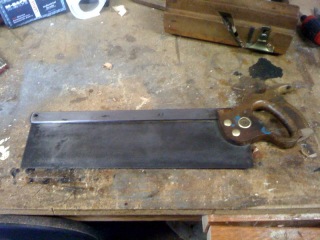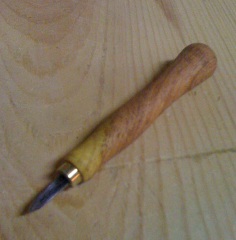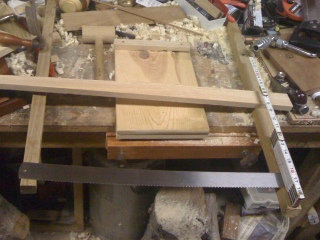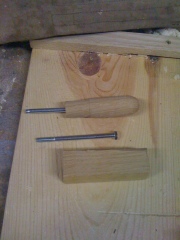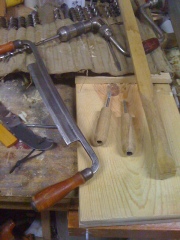Posts in Category: Tools
Removing Rust
I tried a trick for removing rust last night on a Disston possibly No. 4 steel backed backsaw. It’s a tenon saw I think, and I found it for $7 at an antique store with a busted horn on the bottom of the handle, some light pitting on one side of the blade, and a whole lot of surface rust. But for $7 I couldn’t pass it up, especially since the teeth were in great shape, and the blade was straight. Plus, it was $7.
I did some searching on the internet, and found something I could try with what I already had. I took a brand new “scotch brite” type kitchen sponge, sprayed the blade with WD-40, and scrubbed away. It worked quite well, and the rust came off easily. The pitting was only on one side, and doesn’t seem to be too bad, it cleaned up pretty well, and once I put the handle back on the saw it made some decent cuts in some sacrificial pine.
All in all, worth $7. The handle chip on the bottom horn doesn’t impact utility, and is still very comfortable. I might glue a piece of wood and bring the shape back, or I might just use the thing as is. I’ll try and snap some pictures tonight, I didn’t have my iPhone on me last night.
Still working on my Day 2 write up for my visit to Woodwrights School, more on that later.
**edited: added picture of the cleaned up saw**
Marking Knife
I got a little shop time today, and made a new tool. I recently cleared a bunch of space, and got a whole new corner for the shop which I share with the family storage area. While I was cleaning the shop I found a broken jigsaw blade. I read somewhere on the internet that you could make a marking knife out of these. So I gave it a shot.
I used the grinder to shape it a bit, and pointed it on both ends.
Then I turned a piece of Mesquite pen blank I’d gotten in a trade box with some other pen turners.
I cut a piece of brass pen tube I found while cleaning up (a theme perhaps) to make the ferrule.
Then I drilled a hole slight smaller than the width of the tang in the end.
Clamping the blade in the vise, and then hammer with a wooden hammer on the end of the handle I seated the blade into the handle with a few good wacks. It’s pretty solid, and I figure it will work for a bit, and it’s going to get a lot of action as a marking knife so I figure this will be good enough.
Then a quick sharpening on the grinder, and a pass over the sandpaper to flatten the back and done!
A nice quick project, that I can now use to mark accurate dovetails.
– Badger
Bow Saw project started…
I went down to the garage last night try out the new dovetail saw, but got distracted and worked on the bow saw frame instead.
I’m starting with some random Oak I picked up from I have no idea where, but it’s stout and available, so it will do. I’m not following any set plans for this, just kind of winging it which is probably a bad idea. I’m using the blade I bough from Traditional Woodworker that is 24″ blade with a 9 TPI filed for cross cutting. I have a 5 TPI rip blade as well, that I am thinking of making into a frame saw later.
I laid out the blade, and used my little one for the rough proportions to use. I cut a couple of 4″ sections to use as the handles, and set to work on those. The metal shank is 1/4″ bolt which am embedding in the handle. I started with a #4 auger bit (1/4″) in my new/old brace I got a coupe weeks ago, and then drilled a #8 (1/2″) hold for the head. I should have done it in reverse I think, since the bigger hole was slightly offset, which might have worked in my favor.
Small admission, I didn’t exclusively use hand tools for the drilling, I did start the hole with the drill press, but it wasn’t long enough. The brace and auger set up does work well, better than I expected, but it still had some issues. I’m still debating how far down the path I want to go and how fast.
Once I had the holes drilled, which was a small challenge using these in my non wood working vise (all I have for now) and at that height of my bench currently. As I said the holes were not perfectly in line, which meant I could wedge the bolt down in the hole, and it was stuck fast. the shank is not straight out of the handle though, so it might be a problem later. We shall see.
Once I had enough shaft poking out of the end, I chucked it up in my lathe (60 year old Shopsmith 10-ER) drill head, and turned the handle round. I didn’t try for anything fancy, this is one is going to be pretty rough I think since I’m not putting much thought into appearance. I might make another frame later, depending on how this one goes.
Then I put the oak into my bench vise, and started hacking at it with the drawknife. I use the word “hacking” deliberately, because again I wasn’t putting a lot of thought into this part. Mostly I just wanted to see what it could do, and then just kept going. Needs some sharpening but it did a fine job of removing stock as it was. I have a decent handle going already, and I’ll layout a more coherant plan on my next visit to the shop. I wish I had a spokeshave, or more to the point I wish the crappy Harbor Frieght spokeshave wasn’t so crappy. I know, I know, you get what you pay for, and boy howdy I didn’t pay much for this one. I didn’t have high expectations for these, and even then it didn’t work. I might try sharpening again, or maybe just toss them.
More to come, this is stage one and I’ll try and be a little less cavalier with this project later. Last night I think I just wanted to push wood around and sort of “meditate by moving” if that makes any sense, working with my hands is relaxing for me. I am excited to see how this goes together, I did some practice cuts with just the blade it works well. In a frame this could be a work horse. I’ve had bad luck with saws and find them very frustrating usually, so I hope this works for me…
badger
Sharpening with Rob Cosman…
So yesterday I was able to take a class/seminar/sales pitch from Rob Cosman at my local Woodcraft store (other wise known as the place where Badger can spend money very easily). The class was interesting, but I have some minor complaints about. Don’t get me wrong I did learn a lot, and it was interesting, I just kind of expected a little more from it.
We did cover quite a bit, but unfortunately the emphasis was on the expensive, high quality systems that are out of reach for the average wood worker (like most of us in the class). So I learned some really good things about sharpening from Rob, but I also learned a few thing in spite of Rob if that makes any sense.
For now I am going to continue trying the “Scary Sharp” system that I’ve gotten improved results out of already, with my meager setup. But I did learn a lot about bevels and micro bevels that I want to put into practice. I’m also sold on the idea of doing it by hand, with no jigs, that much I agree with him. “Teach a man to fish” and all that.
There was a really nice older gentleman there in the class that I thought was very cool. He’s a few months from retiring, and he’s going to get into making surf boards and move to the coast and surf and make surf boards. How cool is that, he was really interesting and I hope when I hit retirement age I can be that cool. 🙂
The best part of the class though, was afterward, when I asked for a couple quick tips on dovetails. He sort of grudgingly gave me a few pointers, and they were really helpful! He does have is own line of saw, and that makes a difference. “70/20/10” as he called it, 70% Tools, 20% Skill and 10% Practice which makes sense if your livelihood is to sell tools.  Heh. I don’t begrudge him that though, and his dovetail saw is fantastic and worthy of a fair amount of tool lust. However, they were very modern with plastic/resin type handles and progressive pitch. Comfortable and effective, but for my tastes, too “new”. I’m not sure why, but I am more attracted to “old” tools and methods.  I’m willing to work a little harder with the older tools I guess. But the tips gave me made a lot sense, and I’m going to try them out this weekend along with some sharpening.
I did spend a little money though, and got a cheap Crown Tools “Gent’s Saw”, a quart of Tried and True brand boiled linseed oil recommended by Dan over at his blog, and $2 stick of some kind of Rosewood out of the bulk wood scrap bin out front. I’m curious to try the Oil finish on my pegged box I made during the holidays.
I hope to get into the shop this weekend to try out the new toys, and to begin planning out my other purchase which arrived last night in the mail.
Not the bow/frame saw itself, but the blades. I got the two thick 24″ blades pictured, not the turning blade, and I’m intending to build at least one frame for the cross cut, and maybe a rip style frame for the other one. I have some oak lath that I’m going to use for this that I fished out of a bin a while ago. This will be my first mortise and tenon joint (for the cross bar) so that should be a fun learning experience.
— Badger
Recent toolbox scores…
During the holiday break my wife and I were able to get out a bit and do some antiquing, something I never thought would be fun but we quite enjoy. A large part of it for me however is shopping for tools to use in the shop. My recent flirtation with hand tool woodworking has blossomed into a pretty heavy romance, and I can safely say that we’re seeing a lot of each other now. One of the major struggles with this type of woodwork is that the tools are generally expensive, shoddily made, or no longer made at all. The best answer to all three is to find old tools that still have some life left in them, revive them and use them. The old tools are often very well made and can be found cheaply at times. The trick is finding them, and thus we hit the antique stores.
I have a number of other hand tools and what not I’ll post about later, but the recent scores from the holiday shopping are a nice block plane, a frame/bow saw, brace, and really fun folding ruler.
Stanley #60 1/2 Block plane
Found this in an antique store in Portland with very little wear in fantastic condition. Looks hardly used, and a quick sharpening and it was put to immediate use in the shop.
Stanley Boxwood Folding Rule
Bought at the same time as the block plane, this folding rule is a marvel of boxwood and brass hinges. It’s 2 foot rule that folds to 6 inches. The outside is pretty grubby but the inside is still relatively clean. One hinge is a bit dodgy and I need to see if I can fix it up a bit because it’s a pretty useful tool.
Brace
A while back I scored a full roll of auger bits of all sizes, and have been looking for a good usable brace to go along with them. I have this funky cheap knock off brace that had such amazingly warping that was not only useless but dangerous as well. Most braces I find are rusted, or broken but this one had some scrapes on the bit holder, but other wise solid.
Frame/Bow Saw with Turning Blade
Cruising through Second Use is always fun, but this time I found a tool as well as wood. It’s nearly brand new condition, no wear with a sharp blade. Marked with “Clay Sheffield England” on it, it’s a bit of a mystery. The string is all wrong, and already breaking but that can be replaced. The blade is sharp and usable. That and a plank of bamboo plywood and that was a good day of shopping.
More to come as I document my toolbox of hand tools.
— Badger

